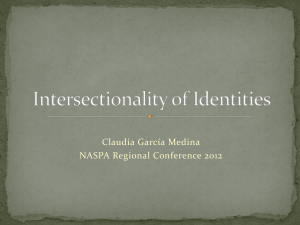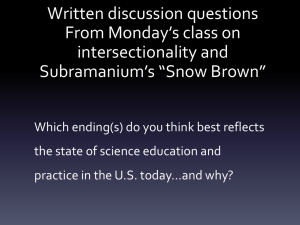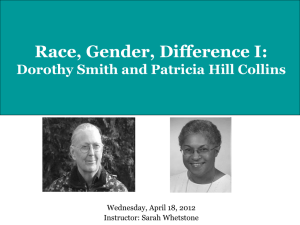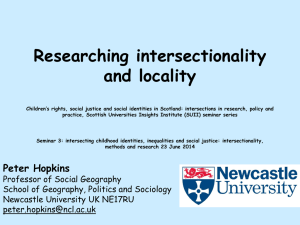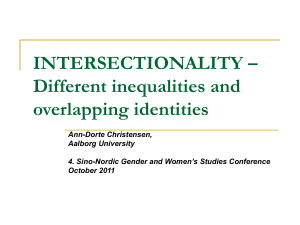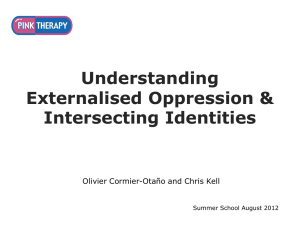Comprehensive Exam Study Guide “Some Group Matters
advertisement
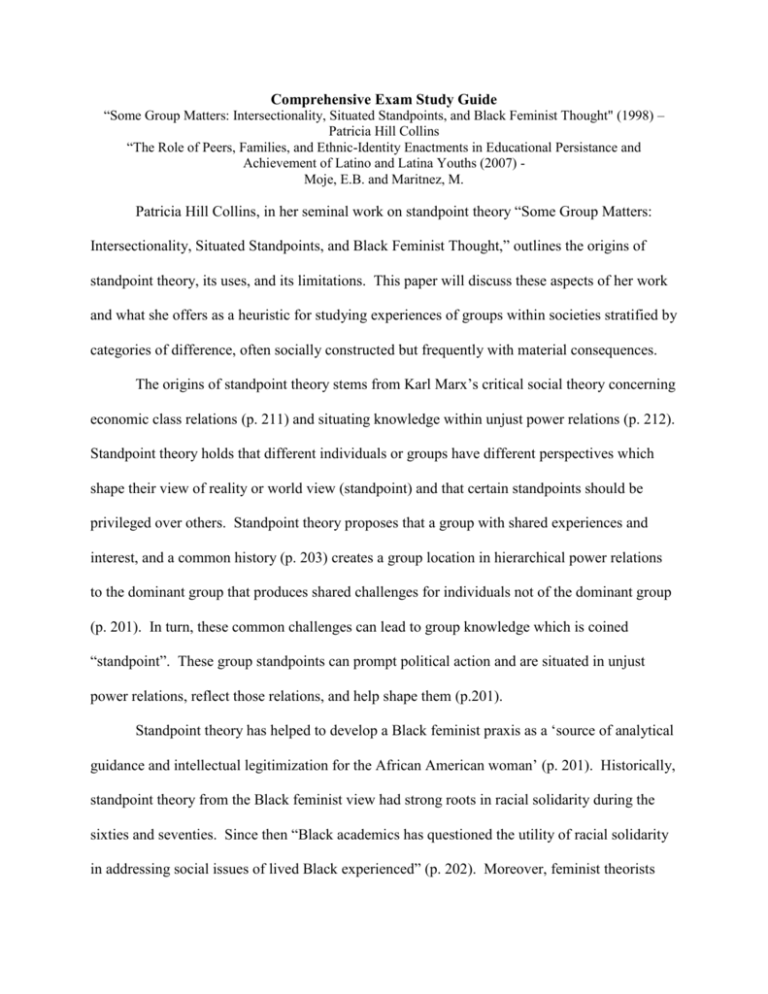
Comprehensive Exam Study Guide “Some Group Matters: Intersectionality, Situated Standpoints, and Black Feminist Thought" (1998) – Patricia Hill Collins “The Role of Peers, Families, and Ethnic-Identity Enactments in Educational Persistance and Achievement of Latino and Latina Youths (2007) Moje, E.B. and Maritnez, M. Patricia Hill Collins, in her seminal work on standpoint theory “Some Group Matters: Intersectionality, Situated Standpoints, and Black Feminist Thought,” outlines the origins of standpoint theory, its uses, and its limitations. This paper will discuss these aspects of her work and what she offers as a heuristic for studying experiences of groups within societies stratified by categories of difference, often socially constructed but frequently with material consequences. The origins of standpoint theory stems from Karl Marx’s critical social theory concerning economic class relations (p. 211) and situating knowledge within unjust power relations (p. 212). Standpoint theory holds that different individuals or groups have different perspectives which shape their view of reality or world view (standpoint) and that certain standpoints should be privileged over others. Standpoint theory proposes that a group with shared experiences and interest, and a common history (p. 203) creates a group location in hierarchical power relations to the dominant group that produces shared challenges for individuals not of the dominant group (p. 201). In turn, these common challenges can lead to group knowledge which is coined “standpoint”. These group standpoints can prompt political action and are situated in unjust power relations, reflect those relations, and help shape them (p.201). Standpoint theory has helped to develop a Black feminist praxis as a ‘source of analytical guidance and intellectual legitimization for the African American woman’ (p. 201). Historically, standpoint theory from the Black feminist view had strong roots in racial solidarity during the sixties and seventies. Since then “Black academics has questioned the utility of racial solidarity in addressing social issues of lived Black experienced” (p. 202). Moreover, feminist theorists criticize standpoint theory on theoretical grounds (p. 202). In addition, collectively, the assumptions that underlie solidarities of variations have come into question from both Black/feminist academics (p. 202). These critiques have general implications for Black feminist praxis and particularly for Black women’s standpoint situated in unjust power relations (p. 202). The shift in paradigm to questioning the efficacy of an identity politics raised questions about standpoint theory’s continued relevance (p. 203). Collins poses these four questions concerning the utility of standpoint theory: 1) Are group-based identities that emerge from standpoint theory and the politics they generate still empowering for African American women?; 2) Do group-based identities such as those advocated by standpoint theory ultimately disempower African American women because they unduly suppress differences and heterogeneity among Black women?; and 3) In what ways, if any, does standpoint theory remain relevant for Black feminist thought? Collins looks at intersectionality and social groups to troubleshoot the questions she posed. She argues that individuals can come together to form an assembly or organization by coming together as an already formed person (p. 203). She further posits that, in contrast, a historically constituted group identity is neither fleeting nor chosen. That is, race creates an immutable identity and gender also is marked in a similar manner (p. 204). The following quote attributed to Iris Marlon young sums this notion up as follows: “One finds oneself as a member of a group, which one experiences as always already having been. (p. 204)” The essential point is that the external boundary markings of race and gender do not dictate how a Black woman constructs their identities within these structures. Collins further explains that groups remain unequal in the powers of self-definition and self-determination within unjust power relations. It is reported that “race, class, gender, and other markers of power intersect to form institutions that, in turn, become defined by these characteristics.” (p. 204). Collins offers the concept of intersectionality as a heuristic for studying the experience of groups within societies stratified by categories of difference, often socially constructed but frequently with material consequences. She states that as an heuristic device that “intersectionality references the ability of social phenomena such as race, class, and gender to mutually construct one another. (p. 205)” Furthermore, the framework of intersectionality can be used to think through social organizations on all levels and patterns of interaction (p. 205). Also, this notion of intersectionality creates fluidity and malleable boundaries around the category “African American women. (p. 205)” “The fluidity of boundaries operates as a new lens that potentially deepens understanding of how the actual mechanisms of institutional power can change dramatically even while they reproduce long-standing group inequalities of race, class, and gender (p. 206).” When state distribution of social rewards in relation to group membership fosters a situation of group competition for scarce resources, policing the boundaries of group membership becomes much more important (p. 206). Intersectionality is more problematic than the former race-, class, and gender-only approaches to social phenomena and also highlights how African American women and other social groups are positioned within unjust power relations. Groups are constructed within these social practices, with each group encountering a distinctive constellation of experiences based on its placement in hierarchical power relations (p. 205). Retaining a focus on groups constructed within and through intersectionalities remains important because it works better as a substantive theory (one aimed at developing principles that can be proved true or false) when applied to individual-level behavior than when documenting group experiences (p. 206). The construct of intersectionality works well with issues of individual agency and human subjectivity and thus has surface validity in explaining everyday life. Individuals can more readily see intersections of race, gender, class, and sexuality in how they construct their identities as individuals than in how social institutions rely on these same ideas in reproducing group identities (p. 206). Collins’ heuristic device of intersectionality can be applied to the context and individuals discussed in the readings of Moje & Martinez and Guisard et al. In the readings of Moje & Martinez, there were two key findings of the study. “First, the physical and cultural space of the community provided opportunities for the Latino/a youth to engage intergenerationally with members of their ethnic cultural community, providing support for youth to maintain ethnic identity tool kits that included Spanish language abilities; knowledge of Latino/a traditions, music, and history; and cultural values. Lastly, formal structures offered human material resources, as well as role models and information, to guide the youth toward postsecondary educational achievements. The authors’ main argument is that educational persistence and achievement is largely influenced by the role of peers, family, and ethnic identity enactments. Additionally, the enactment of these identities are forged or lived through themes of “home fronts” and contact zones (Moje & Martinez, p. 9). “Home front” represents the immediate community were a common culture exists and therefore a threat to one’s cultural identity is not necessarily at odds within the community. The authors suggest the “home front” has interpersonal and other institutional brokerage resources that intertwine and are significant in the lives of Latino/a youth (Moje & Martinez, p. 10). The resilience of the identity forged at the “home front” in the wake of racism and discrimination helps to mediate educational persistence and achievement. On the other hand, contact zones are those places that exist outside of the immediate or local community that tends to see peoples as the “others” due to unequal relations of power. This typically is when conflict exists in how one sees their own ethnic identity in relation to “others”. Moreover, contact zones can exist for some inside of what might be considered a “home front” because of ridicule. In pursuing mainstream academic achievement, youth were considered weird or arrogant (fresa) often referred to as “acting white” (Moje & Martinez, p. 30). This is another instance of using the survival techniques/strategies involve living in double realities (Dowdy, p. 11). From a theoretical perspective, the authors see identities as “always situated in and mediated by social contexts and social group memberships” (Moje & Martinez, p. 1). The youth in this study produced hybrid identities that intertwined “their strong ethnic sense of self with an urban sensibility” (Moje & Martinez, p. 28). The marking of “Mexican” of “Mexican-American” students occurs within the context of interactions at school. Understanding that ethnicity, linguistic background, and class are not unrelated factors but intersect and complicate the notion of single identity, or one of location within a hierarchy of social power. Similarly, Collins agrees with the previous stated notion that the intersection of race, class, and gender becomes problematic when trying to construct group identities which she refers to as “intersectionality” (Collins, p. 205). In the readings of Sirin & Fine, the authors’ reasons for research were to get further insight into negotiated identities, examine hyphenated identities, and the possible mental health issues caused by psychological exclusions (p. 2). Research methods used were mixed methods through surveys, interviews, identity maps, and group talk. Historically, the first wave of immigrants came to the United States between 1870 and 1890 and a second wave ushered in between the mid sixties. A historical significance of this book is 9/11. It is reported that the notion of becoming the “others” after 9/11 and the concept or feeling of living on the hyphen did not dissipate after the initial attacks (p. 2). The readings thus far in the book, Muslim American Youth – Understanding Hyphenated Identities through Multiple Methods, focus on three females. Their names are Aisha, Sahar, and Yeliz. This discussion will focus on Aisha. Aisha is fourteen years of age and attends a public school in Brooklyn, Ney York (p. 25). She is an honors’ student with 90s in all her subjects, while taking AP and honor courses (p. 25). She has desires of going to an ivy-league school but because she is a female she doesn’t get the encouragement at home. Her ID map is doing “daily routines” (p. 25). She is proud of being a Muslim and feels that it is her responsibility to educate others about Islam. She states that “I don’t like when people disrespect me because I am Muslim or Arab. (p. 31)” The author’s close this chapter on Aisha with the following quotes: “For Aisha, life at the hyphen contains challenges, confrontations, and opportunities to critique and resist social injustice. (p. 31)” This represents an intersection of race, ethnicity, gender, and religion as Collins refers to as intersectionality. Collins sheds light on the many ways that identities can be forged through the concept of intersectionality. However, she does mention that we must caution not to use individual experience to theorize group processes because the treatment of the group in standpoint theory is not synonymous with a “family” resemblance (Collins, p. 204).
